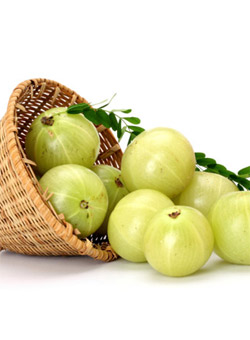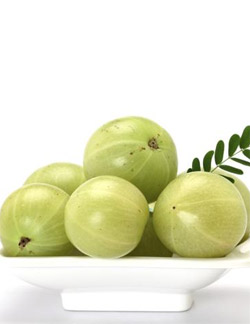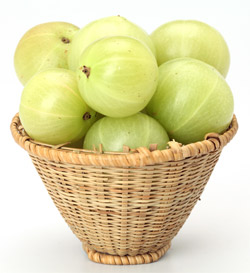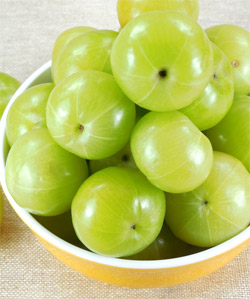|
|
Indian Gooseberry (Amla): Miraculous Health Fruit

Phyllanthus emblica, also known as emblic, emblic myrobalan, myrobalan,
Indian gooseberry, Malacca tree, or amla from Sanskrit amalika, is a deciduous
tree of the family Phyllanthaceae. It is known for its edible fruit of the same
name.
Indian gooseberry has undergone preliminary research, demonstrating in vitro
antiviral and antimicrobial properties. There is preliminary evidence in vitro
that its extracts induce apoptosis and modify gene expression in osteoclasts
involved in rheumatoid arthritis and osteoporosis. It may prove to have
potential activity against some cancers. One recent animal study found treatment
with E. of?cinalis reduced severity of acute pancreatitis (induced by L-arginine
in rats). It also promoted the spontaneous repair and regeneration process of
the pancreas occurring after an acute attack.
Experimental preparations of leaves, bark or fruit have shown potential efficacy
against laboratory models of disease, such as for inflammation, cancer,
age-related renal disease, and diabetes.
A human pilot study demonstrated a reduction of blood cholesterol levels in both
normal and hypercholesterolemic men with treatment. Another recent study with
alloxan-induced diabetic rats given an aqueous amla fruit extract has shown
significant decrease of the blood glucose, as well as triglyceridemic levels and
an improvement of the liver function caused by a normalization of the
liver-specific enzyme alanine transaminase activity.
Although these fruits are reputed to contain high amounts of ascorbic acid
(vitamin C), 445 mg/100g, the specific contents are disputed, and the overall
antioxidant strength of amla may derive instead from its high density of
ellagitannins such as emblicanin A (37%), emblicanin B (33%), punigluconin (12%)
and pedunculagin (14%). It also contains punicafolin and phyllanemblinin A,
phyllanemblin other polyphenols: flavonoids, kaempferol, ellagic acid and gallic
acid.
The tree is considered sacred by Hindus as the Vishnu is believed to dwell here.
The tree is worshipped on Amalaka Ekadashi. In other Hindu myths, Amla is said
to have originated from the drops of Amrit which spilled on earth accidentally,
due to the fight of Gods and Demons after ksheera sagar manthan. And hence also
this religious belief makes claims that it almost cures every disease and is
also good in extending the longevity of life.
In the Sanskrit Buddhist tradition half an amalaka fruit was the final gift to
the Buddhist sangha by the great Indian emperor Ashoka. This is illustrated in
the Ashokavadana in the following verses:
"A great donor, the lord of men, the eminent Maurya Ashoka, has gone from being
lord of Jambudvipa India to being lord of half a myrobalan." (Strong, 1983, p.
99) This deed became so famous that a stupa was created to mark the place of the
event in modern day Patna and was known as the Amalaka stupa.
According to Hindu tradition, Adi Shankara of Kerala composed and recited the
Kanakadhara stotram in praise of Mahalakshmi to make a poor Brahmin lady get
wealth, in return for a single amla presented to her as bhiksha on an auspicious
dwadashi day. Contemporary poet/philosopher Ravi Teja Yelamanchili wrote a book
titled Amalaki. The book is based on Advaita Vedanta of Sri Adi Shankaracharya.
According to a Tamil legend, Avvaiyar, a female poet, ethicist and political
activist of the Sangam period was gifted with one amla by King Athiyaman to give
her long life.
In Theravada Buddhism, this plant is said to have used as the tree for achieved
enlightenment, or Bodhi by twenty first Lord Buddha called "Pussa.
In traditional Indian medicine, dried and fresh fruits of the plant are used.
All parts of the plant are used in various Ayurvedic/Unani medicine (Jawarish
amla) herbal preparations, including the fruit, seed, leaves, root, bark and
flowers. According to Ayurveda, amla fruit is sour (amla) and astringent
(kashaya) in taste (rasa), with sweet (madhura), bitter (tikta) and pungent
(katu) secondary tastes (anurasas). Its qualities (gunas) are light (laghu) and
dry (ruksha), the postdigestive effect (vipaka) is sweet (madhura) and its
energy (virya) is cooling (shita).
 According to Ayurveda, amla balances all three doshas. While amla is unusual in
that it contains five out of the six tastes recognized by Ayurveda, it is most
important to recognize the effects of the "virya", or potency, and "vipaka", or
post-digestive effect. Considered in this light, amla is particularly helpful in
reducing pitta due to its cooling energy. It also balances both Pitta and vata
by virtue of its sweet taste. The kapha is balanced primarily due to its drying
action. It may be used as a rasayana (rejuvenative) to promote longevity, and
traditionally to enhance digestion (dipanapachana), treat constipation
(anuloma), reduce fever (jvaraghna), purify the blood (raktaprasadana), reduce
cough (kasahara), alleviate asthma (svasahara), strengthen the heart (hrdaya),
benefit the eyes (chakshushya), stimulate hair growth (romasanjana), enliven the
body (jivaniya), and enhance intellect (medhya). According to Ayurveda, amla balances all three doshas. While amla is unusual in
that it contains five out of the six tastes recognized by Ayurveda, it is most
important to recognize the effects of the "virya", or potency, and "vipaka", or
post-digestive effect. Considered in this light, amla is particularly helpful in
reducing pitta due to its cooling energy. It also balances both Pitta and vata
by virtue of its sweet taste. The kapha is balanced primarily due to its drying
action. It may be used as a rasayana (rejuvenative) to promote longevity, and
traditionally to enhance digestion (dipanapachana), treat constipation
(anuloma), reduce fever (jvaraghna), purify the blood (raktaprasadana), reduce
cough (kasahara), alleviate asthma (svasahara), strengthen the heart (hrdaya),
benefit the eyes (chakshushya), stimulate hair growth (romasanjana), enliven the
body (jivaniya), and enhance intellect (medhya).
In Ayurvedic polyherbal formulations, Indian gooseberry is a common constituent,
and most notably is the primary ingredient in an ancient herbal rasayana called
hyawanprash.This formula, which contains 43 herbal ingredients as well as
clarified butter, sesame oil, sugar cane juice, and honey, was first mentioned
in the Charaka Samhita as a premier rejuvenative compound.
In Chinese traditional therapy, this fruit is called yuganzi, which is used to
treat throat inflammation. Emblica officinalis tea may ameliorate diabetic
neuropathy due to aldose reductase inhibition. In rats it significantly reduced
blood glucose, food intake, water intake and urine output in diabetic rats
compared with the non- diabetic control group.
The Maharashtra state is one of the largest producers and suppliers of Indian
Gooseberries. In this region the fruit is commonly pickled with salt, oil, and
spices. The amla fruit is eaten raw or cooked into various dishes. In Andhra
Pradesh, tender varieties are used to prepare dal (a lentil preparation), and
amle ka murabbah, a sweet dish indigenous to the northern part of India made by
soaking the berries in sugar syrup until they are candied. It is traditionally
consumed after meals.
Popularly used in inks, shampoos and hair oils, the high tannin content of
Indian gooseberry fruit serves as a mordant for fixing dyes in fabrics. Amla
shampoos and hair oil are traditionally believed to nourish the hair and scalp
and prevent premature grey hair.
Health Benefits of Indian Gooseberry (Amla)
Here are the nutritional benefits present in 100 gm of raw Indian Gooseberry:
-
Energy 352Kcal
-
Carbohydrates 87gm
-
Protein 0.49gm
-
Vitamin C 540mg
-
Calcium 0.21mg
-
Fat 0.09gm
The recommended dosage of Indian Gooseberry (Amla) per day is:
-
Infants (age below 1 year): 30 to 35 mg
-
Children (age 1 to 14 years): 40 to 50 mg
-
Adolescent (age 15 to 18 years): 65 to 75 mg
-
Adult Man (age over 18 years): 90 mg
-
Adult Woman (age over 18 years): 75 mg
 1. Cures Sore Throat and Cold: Amla helps to cure sore throat and cold. For this,
mix 2 teaspoons of amla powder with 2 teaspoons of honey. Have it 3-4 times in a
day for effective results. 1. Cures Sore Throat and Cold: Amla helps to cure sore throat and cold. For this,
mix 2 teaspoons of amla powder with 2 teaspoons of honey. Have it 3-4 times in a
day for effective results.
2. Rich Source of Vitamin C: A great source of vitamin C, consume raw amla daily
instead of vitamin C supplements as it is not easily absorbed by the body.
3. Reduces Constipation: Daily consumption of raw amla reduces constipation
problem, as it rich in fibres and acts as a gentle laxative. But remember to
consume raw amla as powder as juice will not help in this case.
4. Heals Mouth Ulcers: Suffering from mouth ulcers frequently? Then amla juice
is the best solution for your problem. Dilute the amla juice in half a cup of
water. Gargle with this mixture daily for best results.
5. Heals Arthritis Condition: Do you know that amla benefits in reducing
arthritis pain? It has anti-inflammatory properties which help in reducing the
swelling and joint pain of knees caused due to arthritis. Have raw amla or amla
juice daily in the morning.
6. Cures Sleeping Disorder: Can�t have a peaceful sleep? Then try this �wonder
fruit� to relieve stress and therefore cure sleep disorders like insomnia.
7. Improves Eyesight: Amla is very useful in improving eyesight. It also reduces
reddening, itching and watering. Mix 2 teaspoons of amla juice in half a cup of
water and drink it every morning.
8. Removes Toxins from the Body: Consumption of alcohol, pain killers, medicines
etc regularly increases the build up of large amount of toxins in our body. Amla
helps in maintaining the proper functioning of liver and bladder, and get rid of
toxins. Have amla juice on an empty stomach every morning.
9. Regulates Acid Levels in the Stomach: Regular consumption of amla is very
good for your stomach, as it balances the acids levels of stomach and thus
improving digestion.
10. Fights Off Free Radicals: Amla is the powerhouse of anti-oxidants and thus
helps in fighting off free radicals in your body. Daily consumption of raw amla
or juice reduces the risk of many serious diseases including cancer.
11. Improves Metabolism: Are you a fitness enthusiast. Then make amla your best
friend as it helps in increasing your protein metabolism. If you have a high
metabolism, then you lose weight faster. Therefore those who want to lose
weight, have an amla daily to increase your metabolism.
12. Strengthens Respiratory and Central Nervous System: Amla strengthens the
lungs, the respiratory system and the central nervous system of your body.
13. Boosts Immunity: Daily consumption of an amla boosts your immunity due to
its high concentration of vitamin C.
14. Improves Haemoglobin and Purifies Blood: Amla increases the haemoglobin
level in blood, the RBC (red blood cells) count and purifies blood.
15. Maintains Cholesterol Levels: Suffering from high cholesterol an1d looking
for natural alternatives. High cholesterol levels increases the probability of
heart attack and stroke. It builds up and deposits on the walls of the arteries,
thus clogging them completely. For this, have 500 mg of amla powder daily with a
glass of water before going to sleep. It is known to
Reduce LDL (bad cholesterol), VLDL and triglycerides level by over 40%. Increase
the level of HDL (good cholesterol) significantly.
16. Reduces the Risk of Gall Bladder Formation: Amla reduces the risk of gall
stone formation in the gall bladder. When there is excess cholesterol in the
bile, gall stones are formed. Amla helps in reducing them as it contains vitamin
C, which converts the cholesterol into bile acid in the liver. Therefore include
amla in your daily diet to cut down the risk of gall bladder stones.
17. Cures Infections and Ulcers: It helps cure infections, ulcers and reduces
fever due to its anti bacterial, astringent and anti-inflammatory properties.
 18. Prevents Scurvy and Jaundice Outbreak: Drinking amla juice early in the
morning on an empty stomach is a natural tonic to prevent scurvy and jaundice. 18. Prevents Scurvy and Jaundice Outbreak: Drinking amla juice early in the
morning on an empty stomach is a natural tonic to prevent scurvy and jaundice.
19. Cures Diabetes: Diabetes or high blood sugar is the most common and
prevalent disease in the world today.
You would be surprised to know that India has the most number of type 2 diabetic
patients in the world. Thus they have become hugely dependent on insulin or
dialysis.1
The �wonder fruit� is well known to cure diabetes naturally. Amla is rich in
chromium which regulates the carbohydrate metabolism and makes the body more
responsive to insulin, which reduces the blood glucose levels. Mix 2-3 teaspoons
of amla powder or juice in a glass of water and consume daily.
20. Reduces ill Effects of Cigarette Smoke: Studies have shown that intake of amla juice regularly reduces ill effects of the cigarette smoke in the lungs.
Due to its high anti-oxidant contents, it fights off free radicals liberated
from the smoke.
21. Delays Pre-Mature Ageing: Due to the high concentration of anti-oxidants, Amla helps to reduce the effects of pre mature ageing, wrinkles and fine lines.
22. Reduces Facial Lines: It tightens and tones the skin and thus reduces facial
lines.
23. Exfoliates Skin: Amla is a natural exfoliater as it helps in removing the
dead cells and soothes the skin due to astringent properties.
24. Gives Soft and Supple Skin: High content of vitamin C boosts the collagen
cell production, giving you soft, supple and youthful skin.
25. Works on All Skin Types: It can be used on every skin type without any
reaction or irritation.
26. Reduces Pigmentation: Amla is known to reduce pigmentation. With regular
use, it brightens dull and dry skin.
27. Cures Hair Loss: Amla oil is being used since ancient times for hair growth
and as a cure for hair loss.
28. Offers Luster to Dry & Dull Hair: Amla powder used in hair packs strengthens
the hair root and provides the lustre to dry and dull hair.
29. Controls Pre-Mature Hair Greying: It is been used from centuries to control
pre mature greying of the hair.
30. Treats Lice and Dandruff: Amla oil is also an effective treatment for lice
and dandruff.
31. Enhances Natural Hair Colour: When used with henna powder, it helps in
enhancing the natural hair colour.
Indian Gooseberry (Amla) is a wonder fruit with so many health benefits.
Dated 05 February 2015
|
|
|
|
|









